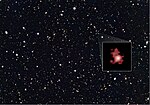astro.wikisort.org - Meteorite
38 Virginis b is a super-Jupiter exoplanet orbiting within the habitable zone of the star 38 Virginis about 108.5 light-years (33.26 parsecs) from Earth in the constellation Virgo. The exoplanet was found by using the radial velocity method, from radial-velocity measurements via observation of Doppler shifts in the spectrum of the planet's parent star.
| Discovery | |
|---|---|
| Discovery date | 29 August 2016 |
Detection method | radial velocity |
| Orbital characteristics | |
Semi-major axis | 1.82 (± 0.07) AU[1] |
| Eccentricity | 0.03 (± 0.04)[1] |
Orbital period (sidereal) | 825.9 (± 6.2)[1] d |
Time of periastron | 2455490.2 ± 177.3[1] |
Argument of periastron | −87.3 ± 77.7[1] |
| Physical characteristics | |
| Mass | 4.51 (± 0.5)[1] MJ |
Characteristics
Mass
38 Virginis b is a super-Jupiter, an exoplanet that has a mass larger than that of the planet Jupiter. It has a minimum mass of 4.51 MJ.[1]
Host star
The planet orbits a (F-type) star named 38 Virginis. The star has a mass of 1.18 M☉ and a radius of around 1.46 R☉. It has a temperature of 6557 K and is about 1.9 billion years old. In comparison, the Sun is about 4.6 billion years old[2] and has a temperature of 5778 K.[3] The star is metal-rich, with a metallicity ([Fe/H]) of 0.16, or 117% the solar amount. Its luminosity (L☉) is 3.48 times that of the Sun.[note 1]
The star's apparent magnitude, or how bright it appears from Earth's perspective, is 6.11. Therefore, 38 Virginis is on the edge of not being visible to the naked eye, but it can be clearly spotted with binoculars.
Orbit
38 Virginis b orbits its star every 825 days at a distance of 1.82 AU (close to Mars's orbital distance from the Sun, which is 1.53 AU). It likely receives 3% more sunlight as the Earth does from the Sun, due to its effective temperature being close to that of the Earth (in fact, only 3 degrees warmer).
Discovery
The search for 38 Virginis b started when its host star was chosen an ideal target for a planet search using the radial velocity method (in which the gravitational pull of a planet on its star is measured by observing the resulting Doppler shift), as stellar activity would not overly mask or mimic Doppler spectroscopy measurements. It was also confirmed that 38 Virginis is neither a binary star nor a quickly rotating star, common false positives when searching for transiting planets. Analysis of the resulting data found that the radial velocity variations most likely indicated the existence of a planet.[1] The net result was an estimate of a 4.52 MJ planetary companion orbiting the star at a distance of 1.82 AU with an eccentricity of 0.03.
The discovery of 38 Virginis b was reported in the online archive arXiv on August 29, 2016.
Notes
- From , where is the luminosity, is the radius, is the effective surface temperature and is the Stefan–Boltzmann constant.
References
- Borgniet, S.; et al. (2017). "Extrasolar planets and brown dwarfs around AF-type stars. IX. The HARPS southern sample". Astronomy and Astrophysics. 599. A57. arXiv:1608.08257. Bibcode:2017A&A...599A..57B. doi:10.1051/0004-6361/201628805.
- Fraser Cain (16 September 2008). "How Old is the Sun?". Universe Today. Retrieved 19 February 2011.
- Fraser Cain (September 15, 2008). "Temperature of the Sun". Universe Today. Retrieved 19 February 2011.
На других языках
- [en] 38 Virginis b
[ru] 38 Девы b
38 Девы b — экзопланета класса «Супер-Юпитер» расположенная в зоне обитаемости звезды 38 Девы, на расстоянии в примерно 108,5 световых лет (33,26 парсек) от Земли, в созвездии Девы. Планета была обнаружена методом Доплеровской спектроскопии, за счёт измерения сдвигов в спектре родной звезды.Другой контент может иметь иную лицензию. Перед использованием материалов сайта WikiSort.org внимательно изучите правила лицензирования конкретных элементов наполнения сайта.
WikiSort.org - проект по пересортировке и дополнению контента Википедии








